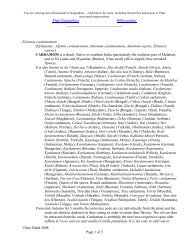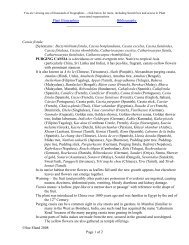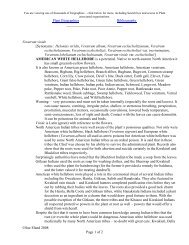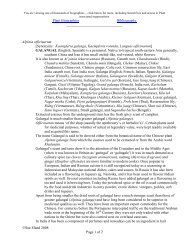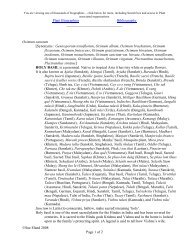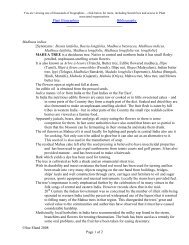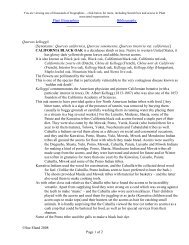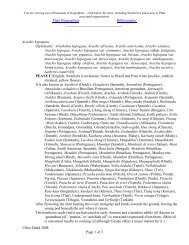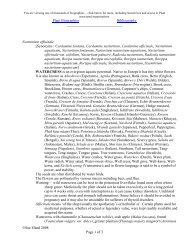Annato - Plant Biographies
Annato - Plant Biographies
Annato - Plant Biographies
Create successful ePaper yourself
Turn your PDF publications into a flip-book with our unique Google optimized e-Paper software.
You are viewing one of thousands of biographies – click below for more, including Search box and access to <strong>Plant</strong><br />
associated organisations.<br />
<strong>Plant</strong> <strong>Biographies</strong><br />
Bibliography<br />
______________________________<br />
Bixa orellana<br />
[Synonyms : Bixa acuminata, Bixa americana, Bixa odorata, Bixa odorata var. leiocarpa, Bixa<br />
platycarpa, Bixa purpurea, Bixa tinctoria, Bixa upatensis, Orellana americana, Orellana<br />
orellana]<br />
ANNATO (Brazilian, English, French, Portuguese, Russian) is an evergreen shrub or tree.<br />
Native to northern South America and to the Caribbean, it has small red, pink, or white<br />
flowers with many stamens.<br />
It is also known as Açafroeira da terra (Brazilian, Portuguese), Açafroa do Brasil (Portuguese),<br />
Achihuite (Colombian, Spanish), Achiote (Japanese, Russian, Spanish), A chi o te<br />
(Korean), Achiote caspi (Spanish), Achuéte (Filipino/Tagalog), Achwete<br />
(Filipino/Tagalog), Acote (Italian), Anato (Portuguese), A na to (Korean), Anatoo<br />
(Japanese), Anatto (Dutch, English, German, Japanese), Anattosamen (German), Anatto<br />
tree, <strong>Annato</strong> (French), <strong>Annato</strong>busken (Danish), <strong>Annato</strong>pöösa (Estonian), Annaatto<br />
(Finnish), Annatta (German), Annatto (English, Italian), Annattobuske (Swedish),<br />
Annatto plant, Annattosamen (German), Annatto seeds, Annatto tree, Annotta, Anotto<br />
(Italian), Arnatto, Arnatto dye plant, Arnotta, Asuete (Filipino/Tagalog), Beni no ki<br />
(Japanese), Bijol (Spanish), Biksa (Russian), Biksa orel’ina (Russian), Bik sa sok<br />
(Korean), Bjoul (Hungarian), Chacuanguarica (Puerto Rican, Spanish), Châm’puu<br />
(Khmer), Châm’puu chrâluëk’ (Khmer), Điêù nħuôm (Vietnamese), Echuete<br />
(Filipino/Tagalog), Galuga (Javanese, Sundanese), Hong mu (Chinese), Hột điều màu<br />
(Vietnamese), Jabra (Tamil), Japhara (Tamil, Telugu), Jarak belanda (Malay), Kam sêt<br />
(Thai), Kam tai (Thai), Kealia (Hawaiian), Kesum (Malay), Kesumba (Indonesian,<br />
Malay), Kesumba kling (Indonesian, Malay), Kh’am (Laotian), Kham faet (Thai), Kham<br />
ngae (Thai), Kham ngo (Thai), Kham thai (Thai), Kongaram (Tamil), Kunyit jawa<br />
(Malay), Lathwa (Hindi), Latka (Bengali), Latkan (Bengali, Hindi), Latkana (Hindi),<br />
Lipstick plant, Lipstick tree, Onoto (Spanish, Venezuelan), Orellana, Orleana, Orleandrvo<br />
(Serbian), Orleánfa (Hungarian), Orleansamen (German), Orleansbaum (German),<br />
Orleanstrauch (German), Orleantræ (Danish), Pomadnoe derevo (Russian), Pumacua<br />
(Puerto Rican, Spanish), Red red, Rocou (Dutch, French), Rocouyer (French), Roucou<br />
(French, West Indian), Roucouyer (French), Rucu (Dutch), Ruku (Hungarian), Sappira<br />
(Tamil), Satii (Laotian), Sendrii (Marathi), Sindhuri (Hindi), Sindur (Nepalese), Sindure<br />
(Nepalese), Sinduri (Sanskrit), Sinduriya (Hindi), Smørfarvetræ (Danish), Sộmz phuu<br />
(Laotian), Sotis (Visayan), Urucú (Brazilian, Portuguese), Urucú bravo (Brazilian,<br />
Portuguese), Urucú da mata (Brazilian, Portuguese), Urucum (Brazilian, Portuguese),<br />
Värvibiksa (Estonian), Woucou (Creole). Yan zhi mu (Chinese), and Yan zhi shu<br />
(Chinese).<br />
Bees are attracted to the flowers. Prickly, brown to rose-coloured fruit shells burst in two when<br />
dry to release the seeds. If the seed-coating has a sweetish smell, it indicates<br />
fermentation, and the best quality has no smell.<br />
An extract of the seed coating has a penetrating bitter saline flavour. An edible colouring matter<br />
is extracted from the fruit lining around the seeds.<br />
Orellana commemorates a Spanish explorer and conquistador, Francisco de Orellana (c. 1490-<br />
c. 1549) who crossed the Andes in 1541 and followed the Amazon River to its mouth<br />
©Sue Eland 2008<br />
Page 1 of 3
after he and his men had been separated from the rest of Gonzalo Pizzaro’s (c. 1506<br />
1548) unsuccessful expedition to find El Dorado. Apparently the Amazon had previously<br />
been called Rio Santa Maria de la Mar Dulce and, after a tribal Indian attack in which<br />
Orellana was convinced he had seen women fighting alongside men, it is held that the<br />
river was re-christened with its present name. These women, who he is said by some<br />
authorities to have also come across living at different points along the riverbank, may<br />
well have been long-haired Indian men and again, according to some authorities, are said<br />
to have reminded Orellana of the Amazon women of Greek myth. According to legend<br />
the women were either female warriors and/or the dominant sex in a land situated on the<br />
edge of the world as then known to the ancient Greeks. (Most of the dates relating to<br />
Orellana seem to be uncertain.)<br />
The Aztecs used annato powder to flavour their drinking chocolate (Theobroma cacao) long<br />
before Europeans invaded the Americas.<br />
Archaeologists have found evidence of annato in ancient Peruvian graves, and some South<br />
American Indian tribes and some Caribbean Indians, believed the plant to be sacred. The<br />
waxy red coating which covers the seeds was used to make a paste with which they<br />
coloured their bodies and decorated their faces, both as peacetime decoration and as war<br />
paint (some claim that it was this that led to the term ‘Red Indian’ and that the red paint<br />
was meant to imbue courage as it would mask warrior’s bleeding wounds during battle).<br />
[Many authorities believe that it was the North American Indian use of chestnut oak<br />
(Quercus prinus) or alternatively bloodroot roots (Sanguinaria canadensis) that led to the<br />
term ‘Red Indian’.] For at least one tribe the paint was also used in rituals at the birth of a<br />
child. To ensure that the child would be, variously, strong in its body or impervious to<br />
witchcraft or grown in health, he or she was (and still can be) painted with the red dye in<br />
dots or designs all over the body when newborn.<br />
Today the dye is still in wide use locally, particularly for colouring ceramics, tools, weapons<br />
and threads. In Ecuador the Colorado Indians use the red paste to mould a traditional<br />
helmet-like hairstyle. Some of the South American Indian tribes also believe that the<br />
orange colour of one of the dyes acts as an insect repellent, particularly for the mosquito.<br />
By the 17 th Century when chocolate was beginning its progress through western Europe annato<br />
was being imported into the Continent not least as one of the ‘essential’ flavourings for<br />
this new drink.During the following Century the orange or red colourings with which<br />
Cheshire and Red Leicester cheeses are associated were obtained by English<br />
cheesemakers from using this new and virtually tasteless natural edible dye.<br />
At the beginning of the 1980s world production of annato was estimated to be about<br />
3,000 tonnes but by the end of that decade this had tripled. As an alternative to many<br />
synthetic food and medicine colouring agents that were attracting restrictions on their<br />
use, annato’s colouring qualities were appreciated, especially by the dairy industry. Brazil<br />
especially has taken advantage of this renewed interest in the crop and although the world<br />
market for colouring additives is small (and the colouring elements extracted from annato<br />
can be variable in quality in commercial terms) other assets have been identified.<br />
Authorities recognise a high yield potential and this, combined with the plant’s stamina<br />
which enables it to be grown in exhausted tropical soils, appears to recommend it<br />
strongly as a viable alternative to a grain crop.<br />
Fibre from the smooth bark has been used for rope.<br />
In parts of America (and in other countries, including Malaysia) the plant is grown as a living<br />
fence.<br />
In India the dye has been used to colour soap, paint and varnish. Locally shoe shiners in the<br />
Philippines used to make a brown shoe polish from the small, angular, orange-red seeds<br />
as well.<br />
©Sue Eland 2008<br />
Page 2 of 3
Although the Spanish are understood to have introduced annato to the Philippines from the east<br />
ie. across the Pacific Ocean, it is believed by some authorities that the plant reached India<br />
from the west – and from there progressed to Malaysia. In the early 1800s authorities<br />
note that annato’s spread through the Indian state of Bengal was believed to be due not<br />
least to its value as a source of a yellow dye. Not long after this, in 1828, Java (now an<br />
Indonesian island) was to value the dye as an export commodity for the European market<br />
and decree that it should be planted along roadsides for this purpose.<br />
Mention has already been made of the commercial use of annato. The food industry uses the<br />
extracted food colouring today to give a red to yellow colour to cheeses eg. Cheddar (as<br />
well as Cheshire and Red Leicester), Edam, or Mimolette, to dried, salted and smoked<br />
fish eg. haddock, and to butter, ice cream, mixed seasonings, frankfurters, sausages,<br />
imitation creams, fish fingers, confectionery and pastries. The powder can provide a far<br />
less expensive alternative for saffron (Crocus sativus) and can be bought for domestic use<br />
in grocery stores in Latin America. However it does have a penetrating flavour and this is<br />
emphasized when one considers that commercially, when used in processed food, the<br />
proportion of annato to the remainder of the ingredients is 1:400.<br />
The colouring is also used today in varnishes and wood stains, as a dye for silk fabrics, and as<br />
colouring in medicine. It is understood that anglers can buy maggots coloured with the<br />
plant’s pigment to make them more alluring for the fish<br />
Medicinally, in India the leaves have been used in remedies for jaundice and snake bites, and in<br />
other parts of Asia they have been used to treat fever. Locally the bark has been used to<br />
treat dysentery and in the prevention of scars after wounds have healed. In Western<br />
medicine the dye has been used as a colouring in ointments.<br />
©Sue Eland 2008<br />
Page 3 of 3



